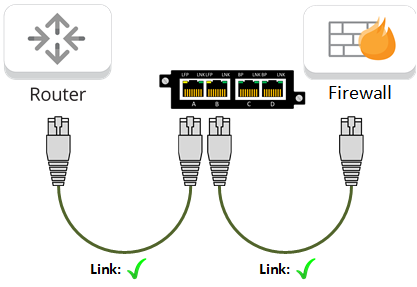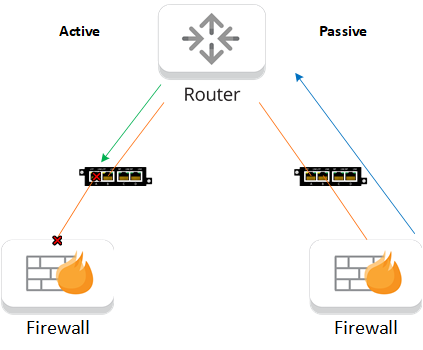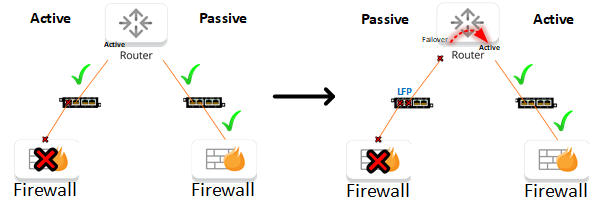

When building a network, uptime and reliability are a major focus in the design of the network. To meet these reliability needs, redundant appliances and links are often put in place to provide high availability for the network. Network visibility is still important in redundant networks and a Network TAP will provide the best source of visibility. If your network consists of gigabit copper links, then it is important to ensure your TAP supports the redundant environment with Link Failure Propagation.
The best way to understand Link Failure Propagation (LFP) is to examine the deployment of a Copper Network TAP:

The copper network TAP fits between two network appliances. In this example, two TAPs are on a router’s redundant links to two separate firewalls set in Active/Passive High Availability. If a firewall fails in this design, the redundant firewall will take over and ensure network traffic continues to be secured.
Looks good so far, but let’s look at how the physical connections treat this situation:

The RJ45 interface on the router and the RJ45 interface on the TAP each establish a link with each other at a physical (Layer 1) level. The same will also occur between the TAP and the firewall. These connections will each send electrical pulses to each other to make sure the connection is still active.
But what happens if the firewall fails and stops responding?
After two missed pulses and no traffic flowing, the RJ45 interface will determine that the link is down between the TAP and the firewall. However, the link between the TAP and the router is still going strong.

In an event like this, the redundant firewall will recognize the outage and begin its High Availability failover process. However, the router will still see it’s link as active and be completely unaware of the issue. In this situation, the redundant firewall could be listening on a link that the router never failed over to all because the TAP never informed the router that the link to the firewall is down.
Link Failure Propagation solves this issue and prevents the TAP from becoming the point of failure in the network.
With LFP, the down state of an RJ45 interface will be replicated over to the adjacent networking RJ45 port.

This will turn off both ports, effectively killing the link on both sides of the TAP.
Now, both networking appliances will know of the outage and perform the appropriate High Availability failover functions. Link Failure Propagation ensures the TAP will not be a point of failure in the network, which means you can capture packets in a redundant network without worry.
Looking to add active TAPs to your next deployment, but not sure where to start? Join us for a brief network Design-IT consultation or demo. No obligation - it’s what we love to do!
If the inline security tool goes off-line, the TAP will bypass the tool and automatically keep the link flowing. The Bypass TAP does this by sending heartbeat packets to the inline security tool. As long as the inline security tool is on-line, the heartbeat packets will be returned to the TAP, and the link traffic will continue to flow through the inline security tool.
If the heartbeat packets are not returned to the TAP (indicating that the inline security tool has gone off-line), the TAP will automatically 'bypass' the inline security tool and keep the link traffic flowing. The TAP also removes the heartbeat packets before sending the network traffic back onto the critical link.
While the TAP is in bypass mode, it continues to send heartbeat packets out to the inline security tool so that once the tool is back on-line, it will begin returning the heartbeat packets back to the TAP indicating that the tool is ready to go back to work. The TAP will then direct the network traffic back through the inline security tool along with the heartbeat packets placing the tool back inline.
Some of you may have noticed a flaw in the logic behind this solution! You say, “What if the TAP should fail because it is also in-line? Then the link will also fail!” The TAP would now be considered a point of failure. That is a good catch – but in our blog on Bypass vs. Failsafe, I explained that if a TAP were to fail or lose power, it must provide failsafe protection to the link it is attached to. So our network TAP will go into Failsafe mode keeping the link flowing.
Single point of failure: a risk to an IT network if one part of the system brings down a larger part of the entire system.
Heartbeat packet: a soft detection technology that monitors the health of inline appliances. Read the heartbeat packet blog here.
Critical link: the connection between two or more network devices or appliances that if the connection fails then the network is disrupted.